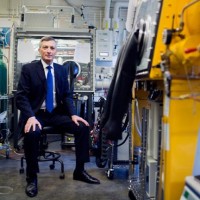Tag archives: chemistry
Canada’s birthday physics, Liberty’s true colours, Trump’s Science cover
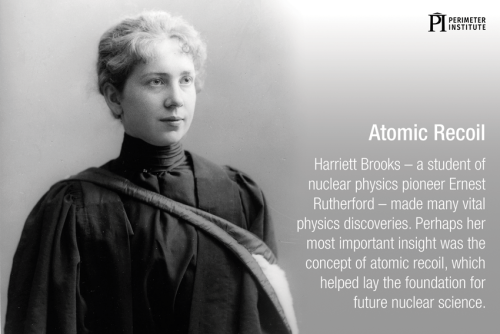
Famous Canadian: nuclear pioneer Harriett Brooks. (Courtesy: PI)
By Hamish Johnston
Tomorrow (1 July) is the 150th birthday of Canada. Or more precisely the anniversary of the day when three British colonies (one of which was already called Canada) joined together and started the long and peaceful journey to becoming fully independent of the UK in 1982. How very Canadian, and I should know because I am one of the 36 million Canadians who will be celebrating tomorrow.
Synonymous with physics in Canada over the past decade or so is the Perimeter Institute for Theoretical Physics in Waterloo, Ontario. Folks there have put together a selection of “13 physics innovations you may not know are Canadian”. I wasn’t aware of some of the innovations, including the work of Harriett Brooks (above). But I am pleased to say that I have met both of the physics Nobel laureates mentioned in the article – Art McDonald and Bert Brockhouse.
View all posts by this author | View this author's profile
Send a birthday card to Fermilab, a huge periodic table, art meets quantum computing
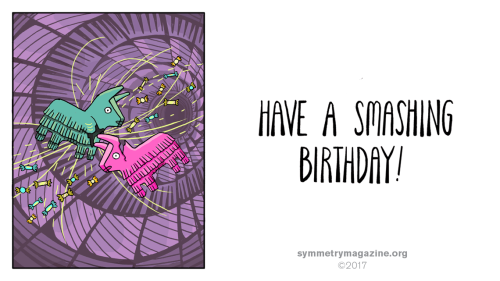
Best wishes: a birthday card for Fermilab (Courtesy: Corinne Mucha/ Symmetry)
By Hamish Johnston and Sarah Tesh
50 years ago this month, the particle physics facility that was to become Fermilab opened its doors for the first time. To celebrate a half a century of physics on the Illinois prairie, the folks at Symmetry have produced a set of themed birthday cards that you can print-out and send to your friends and family. Indeed, there is still time to send a card to Fermilab itself, because the big day isn’t until next Thursday (15th of June). My favourite card (above) uses colliding piñatas to illustrate the plethora of particles that were produced in Fermilab’s Tevatron – which smashed together protons and antiprotons between 1983-2011.
View all posts by this author | View this author's profile
John Ellis on physics after the Higgs boson, calculating the loudness of the Big Bang, the chemistry of ironing
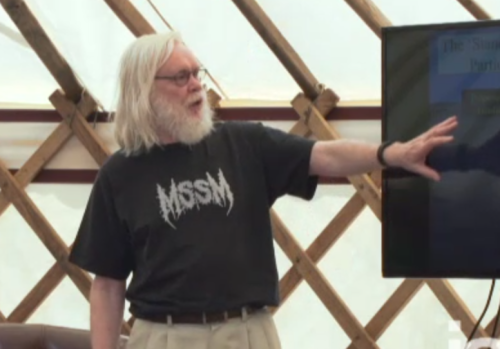
Looking ahead: John Ellis on the future of particle physics. (Courtesy: IAI TV)
By Hamish Johnston
In 2012 particle physicists gave themselves a giant pat on the back when the Higgs boson was discovered at the Large Hadron Collider at CERN – nearly 50 years after it was first predicted to exist. But what have particle physicists done since, and what does the future hold for the field? In a video called “After the Higgs boson: what’s next for 21st century physics?” from the Institute of Art and Ideas, the theoretical physicist John Ellis charts the future course of particle physics. Pay attention for a joke about the UK’s foreign secretary Boris Johnson.
View all posts by this author | View this author's profile
Pillars of light in the sky, an atomic knot and an atlas of physics
By Sarah Tesh
If I got woken in the middle of the night by my screaming child and then saw beams of light in the sky, I think I’d be worried. When Timmy Joe in Ontario saw them, however, he assumed the multi-coloured beams were the Northern Lights. Turns out they were actually caused by the extreme cold. Moisture was freezing so fast that it formed ice flakes only a few molecules thick that could float in the air. These then refracted the city lights to create a colourful light show in the night sky.
Celtic god of thunder gets an attosecond makeover
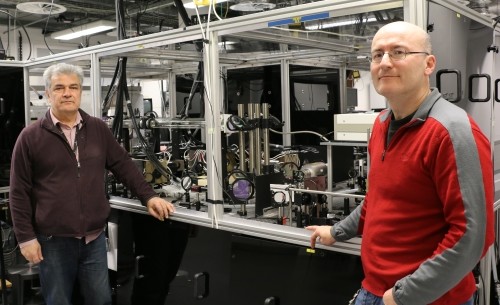
Gods of thunder: Gagik Nersisyan (left) and Matt Zepf at the TARANIS laser facility.
By Hamish Johnston
I recently had the pleasure of visiting Matt Zepf, who directs the Centre for Plasma Physics at Queen’s University Belfast. Zepf and his colleague Gagik Nersisyan showed me around the TARANIS laser facility, which creates extremely bright flashes of light just like its namesake the Celtic god of thunder.
TARANIS is about to upgraded to TARANIS-X, which will deliver ultrashort pulses of extreme ultraviolet light (EUV) that are just a few attoseconds (10–18 s) in duration. Each attosecond pulse will deliver more than 10 µJ, which Zepf says will make TARANIS-X the most powerful laser of its kind by a comfortable margin.
View all posts by this author | View this author's profile
Faraday explodes in court, NIST is entangled in dance, and Oliver Sacks’ periodic table
By Hamish Johnston and Michael Banks
You may remember back in 2013 when researchers at the National Institute of Standards and Technology (NIST) in the US entangled the motion of a tiny mechanical drum with a microwave field for the first time ever. Not content with that feat, NIST physicist Ray Simmonds, who was involved in the work, has now made a dance about it (but no song, yet). Teaming up with choreographer Sam Mitchell, the duo has created a modern dance piece entitled Dunamis Novem (“The chance happening of nine things”). Featuring four dancers, their movements are based on nine quantized energy levels of a harmonic oscillator – like the microscopic drum in the NIST work. For each level, Mitchell created corresponding dance actions, while Simmonds created a random-number generator – to add some “quantum randomness” – for the sequence of levels that the dancers perform at. If the dancers happen to touch each other, their actions become synchronized, which can then only be broken by a beam of light – demonstrating that a measurement collapses the entanglement.
NIST has published a Q&A with Mitchell and Simmonds with links to videos of the dance and the animations of the corresponding energy levels of the harmonic oscillator. A video of the first half of Dunamis Novem is shown above and a video of the entire dance is also available.
Food for Martian thought, proton role-playing in a video game and more
By Tushna Commissariat
With space agencies across the world planning manned missions to Mars in the coming decades, pondering what one would eat while on Mars seems like a sensible thing to do. SpaceX engineer Andrew Rader helps us out with this difficult question in the video above, sharing gems like “chickens can’t swallow in space.” In the video, titled “Cooking on Mars” Rader cooks and eats a seemingly unappetizing option – bugs and insects – and makes it clear that is the fare future astronauts will be partaking in.
View all posts by this author | View this author's profile
Winning rock-paper-scissors, meeting a future Nobel laureate, hot new batteries and more
By Hamish Johnston
When I was a PhD student, there was a group of retired professors that shared a tiny office in the physics department. It was whispered that one of them was extremely wealthy thanks to a successful commercial spin-out and we marvelled at the fact that he came in to work every day rather than enjoying the fruits of his labours. However, it wasn’t the wealthy professor who was destined for international fame. In 1994 his officemate Bertram Brockhouse shared the Nobel Prize for Physics, and Brockhouse’s quiet life changed dramatically. Indeed, he got his own office!
I was reminded of this little group when I read ZapperZ’s blog entry about his encounter with Ray Davis before Davis bagged the 2002 Nobel for his work on neutrinos. Sitting next to Davis on a two-hour flight, ZapperZ had an inkling that he was beside an interesting character after their brief chat about physics. But it wasn’t until the Nobel was announced several years later that he realized the opportunity he had missed.
View all posts by this author | View this author's profile
Cruise-ship physics, the many ways to tie a tie, shaken-up carbon dating and more
By Tushna Commissariat
If you like piña coladas and quantum mechanics, then we hope you are currently on the two-week “Bright Horizons 19” Southeast Asia cruise, as on board is physicist and writer Sean Carroll. He will be giving multiple lectures over the next 15 days on everything from the Higgs boson to dark matter and other fundamentals of quantum mechanics. Also floating along with Carroll are other lecturers who will cover topics from natural history to genetics to military strategy. If, like us, you are stuck at home, you can take a look at Carroll’s slides on his blog, maybe have a cocktail while you are at it.
View all posts by this author | View this author's profile
